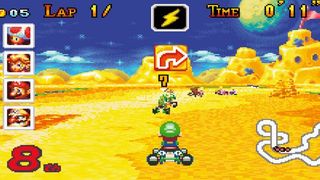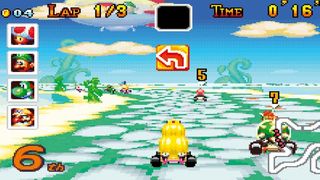How Super Circuit paved the way for modern Mario Kart
Released in 2001, the GBA played host to so many SNES ports, remakes and remasters that it confused more casual punters: was it a new platform, or an old one in disguise? Released the same year, Mario Kart: Super Circuit did its level best to invert the identity crisis, answering that question with a flurry of shells and a honk of the horn. With this game in the slot, GBA was essentially both.
Nintendo’s first handheld Mario Kart game was a glorious coming together of old and new, two sides of the same golden coin. Packed onto the battery-sized cartridge were an incredible 40 tracks: 20 remakes, cherry-picked from the previous SNES and N64 versions and 20 entirely new ones. That shouldn’t come as a surprise, of course. Nintendo is aware of its rich history and has always looked to the past as much as the future. It is surprising, however, that it managed this on something as small as the GBA, especially at a time when many weren’t making the effort.

There were five modes in all: Mario GP, Quick Run, Time Trial, VS and Battle. Let’s start with the first. Mario GP, consistent with all GPs before and after, comprised of a series of cups in ascending order of difficulty: Mushroom, Flower, Lightning, Star and Special. Peach Circuit started beginners off on something wide, flat and very pink, but it wasn’t long before the tracks started to get devious. Shy Guy Beach introduced scuttling red crabs that snagged under tires and slowed karts down, while Bowser’s Castle had racers needing to time daring passes under Thwomps, which splattered anyone unlucky enough to be caught in their shadow. Players needed to watch out for warped roads around these skittering obstacles, too, trickiest of which were levels with bottomless drops, such as Boo Lake and Sky Garden.
Whatever the course, the one constant was distinctiveness. Luigi Circuit, for example, took place in a downpour, with rain forming puddles positioned deliberately to send you skidding. Snow Land went further, with pools you could actually sink in (Lakitu would pull you out as a thick block of ice). All seven (eep!) variations of Bowser Castle, meanwhile, featured red-hot lava. Other tracks contained mercifully fewer dangerous distractions; Cheep-Cheep Island was notable for the giant Cheep-Cheep performing dolphin-like leaps in the distance, whereas Sunset Wilds was the only track to progress from evening to night as you raced. Some were easy (Ribbon Road) and some were hard (Bowser Castle 4). Some were conventional (Mario Circuit) and some upset the lactose intolerant (Cheese Land).

You have to admire the soundtrack to each course, too. From Riverside Park’s tropical pairing of bongo drums and birdsong, to Snow Land’s Christmas bells, to Bowser Castle’s frenetic bass, that Nintendo managed not only to fit so many songs onto the cart, but also to make them so catchy (try getting Yoshi Desert’s Middle Eastern licks out of your head) is incredible.
Whereas Mario GP was an established feature of Mario Kart, Quick Run mode was brand new. Here you could embark on a single race, toggling coins and item boxes on or off, setting the number of laps, the speed and – provided you were racing AI opponents – the difficulty. It let players tackle a track at their own pace. This made Quick Run a perfect starting point for Time Trial mode, itself free from the hustle and bustle entirely. There were no coins or item pick-ups here: the allowance was just three mushrooms bestowed at the start of each race. This was less a competition with others than a contest with yourself, but Nintendo found a way to introduce a social element. Using a link cable, players could share ghost data between themselves. One player could therefore race against a phantom echo of their chum, even if said chum wasn’t playing. Clever stuff.

There was also more active competition, thanks to the ability to link with up to three other people in VS mode. The system limitations precluded AI competitors, but the tight, balanced gameplay we’ve come to associate with the series was in full effect. Multiplayer battles pitted players against each other in an arena with the aim of popping each other’s balloons with shells. VS races even managed an early version of DS Download Play. As long as one person had a cartridge (and a link-up cable), your GBA could download a ‘lite’ version of the game. You may only have been able to play as a selection of blue, pink, yellow or green Yoshis over just four tracks, but it was a generous feature to the 12-year-old kid who couldn’t even afford a Chupa Chups.
Sign up to the 12DOVE Newsletter
Weekly digests, tales from the communities you love, and more
Four-man multiplayer assured more of Mario Kart’s trademark argy-bargy. Full speed contact was even more of a gamble in Super Circuit, thanks to golden coins, which only returned in Mario Kart 7. There were 55 on each track and grabbing them was key to success. Each shiny penny made the kart incrementally faster, providing an impromptu, but handy, racing line in the process. If your coin purse was empty, any collision with an obstacle, item or vehicle would send you spinning out in a squeal of rubber. Coins also unlocked the 20 SNES tracks hidden away and counted towards rankings at the end of each grand prix, making Super Circuit one of the hardest Mario Kart games at which to excel – a reason some gamers still curse its name to this day.

There were eight characters, a bare bones roster by today’s standards, but these were the original icons. Mario, Luigi, Toad, Donkey Kong, Bowser, Peach, Yoshi and Wario each had differing speeds and weights. Brilliantly, these simple statistics attracted controversy from Nintendo nuts. Here, Bowser was said to be heavier than Donkey Kong and Yoshi weightier than Peach. These discrepancies in the canon were addressed in future Mario Karts, which featured a heavier DK and a lighter Yoshi (let’s face it, it’s a dainty dinosaur that can float).
Indeed, Mario Kart’s never been afraid to alter itself. Early screens printed in Nintendo Power promised a very different Mario Kart to the one we got. Character sprites had huge heads and backgrounds had a painterly quality not unlike Skyward Sword. Several pick-ups also failed to make the cut. The fake item box (an obstacle masquerading as an item), banana bunch (a group of three bananas), and golden mushroom (infinite boost for a short period) later appeared in Mario Kart: Double Dash!!.
On a platform where simple ports became all too commonplace, Mario Kart: Super Circuit was right to throw both old and new ideas into the pot. Like the handheld itself, this was a revisit and a revolution rolled into one. A renaissance. The GBA was an excellent device, then, but it had one problem: there weren’t enough games like Mario Kart: Super Circuit.

















